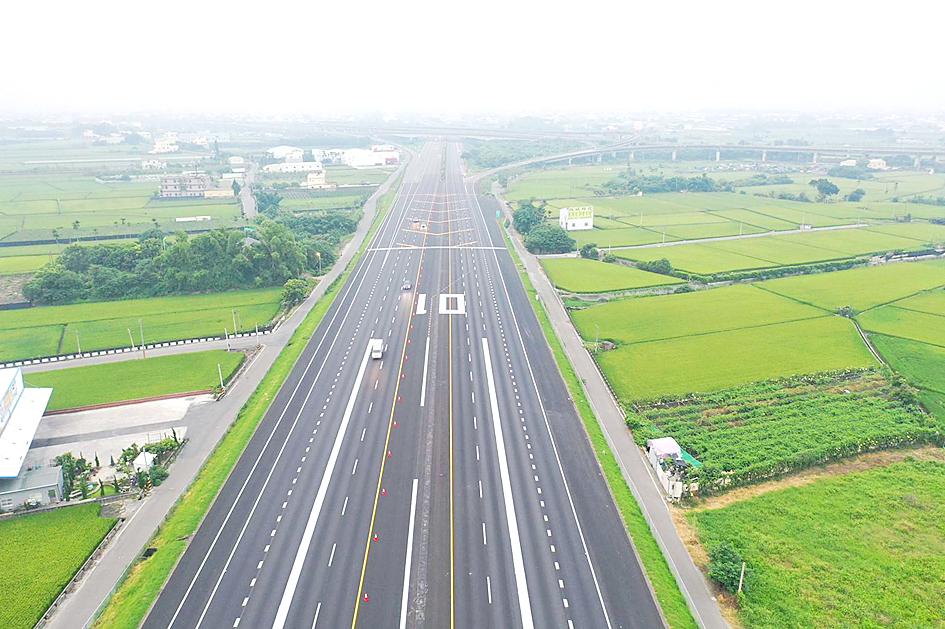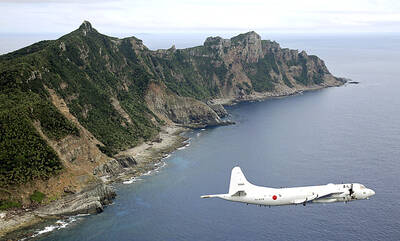The Ministry of National Defense is reportedly considering using a portion of Provincial Highway No. 9 in Taitung County as an emergency runway, following calls last month for a contingency landing strip better protected from Chinese missiles.
The highway is undergoing a years-long improvement plan that includes a new extension skirting the edge of Guanshan Township (關山), fueling rumors that the ministry intends to use it as the nation’s sixth emergency runway, the only one that would be on the east coast.
Minister of Transportation and Communications Wang Kwo-tsai (王國材) yesterday confirmed that the defense ministry wants a contingency runway to be built on the east coast, promising full cooperation regarding its ultimate decision.

Photo courtesy of the Freeway Bureau
The original feasibility study for the highway improvement project did not account for use as a runway, which would require a wider road, Directorate-General of Highways Director-General Hsu Cheng-chang (許鉦漳) said.
The defense ministry has been asked to finalize the plan so that the ministries can work together on preparations, he added.
A defense official speaking on condition of anonymity did not deny the plan, but said that many steps would still need to be taken before it could be confirmed.
The existing stretch of Highway No. 9 that runs through Guanshan is only 15m wide, but cannot be easily widened without expropriating and demolishing private buildings.
Transportation officials therefore decided to build a new 30m-wide stretch of road around the town, although a military runway would have to be even wider.
Work on the highway improvement project covering a total of 45.8km is scheduled to be completed in 2027.
The only other provincial highway used as a contingency landing strip is Provincial Highway No. 1 in Pingtung County’s Jiadong Township (佳冬), where fighter jets practiced landing during the annual Han Kuang exercises last month.
Additional reporting by Aaron Tu

MISINFORMATION: The generated content tends to adopt China’s official stance, such as ‘Taiwan is currently governed by the Chinese central government,’ the NSB said Five China-developed artificial intelligence (AI) language models exhibit cybersecurity risks and content biases, an inspection conducted by the National Security Bureau (NSB) showed. The five AI tools are: DeepSeek, Doubao (豆包), Yiyan (文心一言), Tongyi (通義千問) and Yuanbao (騰訊元寶), the bureau said, advising people to remain vigilant to protect personal data privacy and corporate business secrets. The NSB said it, in accordance with the National Intelligence Services Act (國家情報工作法), has reviewed international cybersecurity reports and intelligence, and coordinated with the Ministry of Justice Investigation Bureau and the National Police Agency’s Criminal Investigation Bureau to conduct an inspection of China-made AI language

LIMITS: While China increases military pressure on Taiwan and expands its use of cognitive warfare, it is unwilling to target tech supply chains, the report said US and Taiwan military officials have warned that the Chinese People’s Liberation Army (PLA) could implement a blockade within “a matter of hours” and need only “minimal conversion time” prior to an attack on Taiwan, a report released on Tuesday by the US Senate’s China Economic and Security Review Commission said. “While there is no indication that China is planning an imminent attack, the United States and its allies and partners can no longer assume that a Taiwan contingency is a distant possibility for which they would have ample time to prepare,” it said. The commission made the comments in its annual

‘TROUBLEMAKER’: Most countries believe that it is China — rather than Taiwan — that is undermining regional peace and stability with its coercive tactics, the president said China should restrain itself and refrain from being a troublemaker that sabotages peace and stability in the Indo-Pacific region, President William Lai (賴清德) said yesterday. Lai made the remarks after China Coast Guard vessels sailed into disputed waters off the Senkaku Islands — known as the Diaoyutai Islands (釣魚台) in Taiwan — following a remark Japanese Prime Minister Sanae Takaichi made regarding Taiwan. Takaichi during a parliamentary session on Nov. 7 said that a “Taiwan contingency” involving a Chinese naval blockade could qualify as a “survival-threatening situation” for Japan, and trigger Tokyo’s deployment of its military for defense. Asked about the escalating tensions

DISPUTE: A Chinese official prompted a formal protest from Tokyo by saying that ‘the dirty head that sticks itself out must be cut off,’ after Takaichi’s Taiwan remarks Four armed China Coast Guard vessels yesterday morning sailed through disputed waters controlled by Japan, amid a diplomatic spat following Japanese Prime Minister Sanae Takaichi’s comments on Taiwan. The four ships sailed around the Senkaku Islands — known as the Diaoyutai Islands (釣魚台) to Taiwan, and which Taiwan and China also claim — on Saturday before entering Japanese waters yesterday and left, the Japan Coast Guard said. The China Coast Guard said in a statement that it carried out a “rights enforcement patrol” through the waters and that it was a lawful operation. As of the end of last month,